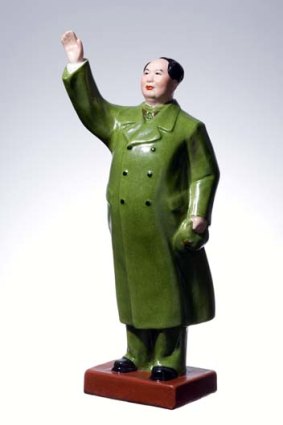
A porcelain Chairman.Credit: Getty Images
Penny Watson surveys the cult of the Chairman, in badges and busts.
One of the great understatements of recorded history goes like this: "I read some pamphlets about anarchism and I was influenced greatly." The translation is from a quote by Chairman Mao, leader of the Chinese Revolution and founding president of the People's Republic. It's just one of the nuggets of intrigue to be found at the obscure Mao Zedong Badge Exhibition Hall, on the outskirts of Dalian, in China's Liaoning province.
Dalian is one of China's "second tier" cities, a metropolis of more than 6 million people with "attractions" such as a financial and logistics hub and shipping centre. But its position on both the Bohai and Yellow sea coasts gives it the edge over many Chinese cities. Recent initiatives such as the promotion of historical sites from the Sino-Japanese War and upgrading the 30-kilometre Binhai coastal road - the longest uninterrupted coastal route in China - have helped put Dalian on the map for travellers other than those who come on business.
That's not to say the Mao Zedong Badge Exhibition Hall, firmly dedicated to the cult of Chairman Mao, is on everyone's itinerary. Housed in a white building with faux-colonnades, it looks like a long-forgotten movie set and vies for attention with a wax museum and a biology exhibition featuring a 1950s science-lab display of skinned animals.
A large painting of a young Mao in flowing monastic garb greets visitors who climb the hall's stairs to the exhibition space. Inside, it's Chairman Mao World, with no apparent tongue in cheek. There are close to 200,000 badges here - big, small, embossed, plate-size porcelain badges cradled in silk-lined boxes, gold and silver badges, heart-shaped ones, badges with moving parts, framed badges and box sets.
On each one, the man himself is featured in various states of propagandist glory: Mao showing a left(ist) profile, Mao clapping, Mao in hat with flags fluttering behind, Mao with right arm raised to the people, Mao walking saint-like across a field of wheat. There are badges with slogans: "Be Chairman Mao's good soldier", and the slightly less catchy "The brilliant radiance of Mao Zedong Thought eternally illuminates the advancing people's army".
I stroll past Mao busts, larger-than-life statues depicting him with hat in hand and crouching with a beaker by his side. There are photos of the Chairman rabble-rousing in village squares, talking with peasants and espousing wisdom to children. All the while, Mao flags flutter above me and the distinctive crackling soundtrack of a revolutionary propaganda film can be heard in the background.
The quantity of badges is certainly exceptional. It goes unexplained in the hall but, as I discover later, badges were manufactured in massive quantities during the Cultural Revolution from 1966. "Factories, work units and army units across the country stamped out over several billion badges in tens of thousands of varieties", according to one paper about the era posted online.
Badges were said to be in such demand the Chinese queued overnight for them and stores sold out rapidly. Despite the socialist mindset, a black market for Mao badges emerged. By 1969, it is thought that 90 per cent of people wore them (an accessory that may have paired with Mao's "little red book", another mass-production relic of the revolution).
Despite the exhibition's fascinating chronicle of this aspect of the Cultural Revolution, it's hard not to be taken aback by the apparent idolatry on display. To some outsiders, Mao is regarded as the leader who presided over the deaths of millions of Chinese by way of starvation and mass suicide, as well as being responsible for stripping China of its cultural treasures and relics.
In China, his legacy is less clear-cut. To some he is still considered a great political and military strategist and is remembered with such sobriquets as the "Great Helmsman" and "Saviour of the Nation". Mao statues can still be found in regional town squares.
I probe my tour guide for insight, but she has a distinctly shoulder-shrugging attitude. By way of explanation she tells me that the badge collector, Mr Cheng De, who began collecting in 1981, "did it because he has interest and respect for Chairman Mao. Visitors are less obsessed with Mao, more intrigued by the sheer number of badges," she says.
After an hour absorbed in a hall dedicated to one element of China's history, I hurry through the souvenir shop, past rows of Mao key rings, jade Mao amulets, stamps, clocks, plates, plaques and gold cufflinks. Inexplicably, there don't appear to be any Mao badges, or replicas, for sale. Are they unavailable - or have they just sold out here, too?
Penny Watson stayed courtesy of Dalian New World Hotel.
China Eastern Airlines has a fare to Dalian from Sydney and Melbourne for about $880 low-season return, including tax. Fly to Shanghai (about 10hr), then to Dalian (2hr); see www.flychinaeastern.com. Australians require a visa for a stay of up to 30 days. The Mao Zedong Badge Exhibition Hall is at Dalian's Golden Pebble Beach National Tourism Resort, about 50 kilometres from the city. Exhibition hours are 8am-4.30pm daily. Admission 10 yuan ($1.60). Phone +86 411 8790 2913.
Sign up for the Traveller Deals newsletter
Get exclusive travel deals delivered straight to your inbox. Sign up now.